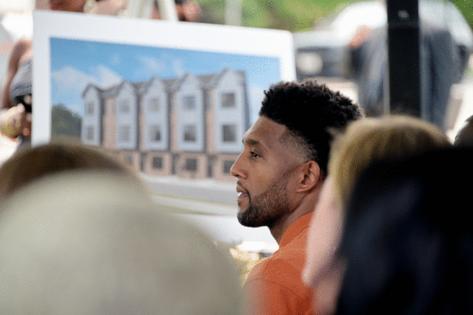Baltimore Mayor Brandon Scott, Gov. Wes Moore make progress on housing, but hurdles remain
Published in News & Features
BALTIMORE — Baltimore Mayor Brandon Scott’s plan to build new housing to replace vacant units is making progress, but some hurdles remain.
Maryland and Baltimore are racing to confront a deepening housing crisis — one defined by soaring rents, crumbling vacant properties, and a chronic shortage of affordable units. While state and city leaders have outlined bold, billion-dollar strategies to build, rehabilitate, and preserve housing, they face a maze of obstacles: budget shortfalls, bureaucratic delays, aging infrastructure, and the looming threat of federal funding cuts. For thousands of families, the stakes are immediate — stable housing hangs in the balance.
As of this month, there are less than 13,000 vacant units in Baltimore City. This number has been steadily decreasing over the last five years, with more than 16,000 vacancies reported in January 2020.
The city is on track to increase its rate of reducing the number of vacant units from 500 a year to 1,000 a year, Maryland Housing and Community Development Secretary Jake Day said.
There’s an opening for Baltimore to possibly help fill the housing shortage in Maryland, which sits at about 96,000 units.
The Eager Park Partners’ East Baltimore Development Project, which the mayor’s office said is a part of the first new residential development in the Broadway East neighborhood in decades, broke ground during a Tuesday ceremony. The project plans to build 54 townhomes in place of once-vacant townhomes.
“It’s made possible by the funding support from the state, from all our partners to make sure that we do not stop, that we keep building and we keep getting rid of vacants.” Scott said at the groundbreaking ceremony.
This is the latest step towards building livable housing in Baltimore, where vacant units once were, as the city has seen many residents move outside of its limits in recent years. Last year was the first year since 2014 that the Baltimore population did not decrease. It grew by 754 residents.
The mayor’s plan to address vacant housing includes a 15-year plan to invest $3 billion in acquiring vacant properties and later rehabilitating the units or demolishing them to construct new housing. He has also made efforts to change some zoning laws that have made building high-density housing difficult.
Gov. Wes Moore has also prioritized replacing or revitalizing vacant properties in Baltimore. The governor signed an executive order last fall to create a “Reinvest Baltimore” program to coordinate the transformation of 5,000 vacant units into owned homes or other “positive outcomes” within the next five years.
Moore is also working to expand affordable housing across the state, especially near transit hubs.
Hurdles ahead
However, Scott and Moore’s housing plans to encourage more people to move to Baltimore could be impacted by planned federal cuts to housing programs. This includes significant cuts to Section 8 and other federal rental assistance programs, proposed as part of a major Republican tax and spending bill being considered by Congress.
Day said he is concerned about the proposed cuts to housing-related programs, but added that because there are state and city resources investing in housing in the area, the cuts would likely impact Baltimore City less than other areas of the country.
“It will affect all housing, it’s going to affect every jurisdiction,” Day said. “Baltimore might actually be in a slightly more advantageous position to other places given the investment that we’re trying to make here.”
There are also concerns about how these developments will impact the makeup of Baltimore and whether they will lead to the gentrification of neighborhoods.
Scott downplayed these concerns when asked by The Baltimore Sun and pointed to the developers of the Broadway East neighborhood development, who are from Baltimore. The mayor said that these housing projects, which replace vacant units, have already led to families moving back to the city.
_____
©2025 Baltimore Sun. Visit baltimoresun.com. Distributed by Tribune Content Agency, LLC.







Comments